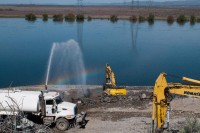Blog post by Miles Johnson, Riverkeeper’s Clean Water Attorney—

The Washington Department of Ecology (Ecology) is re-issuing a permit that allows the U.S. Department of Energy (Energy) to dump millions of gallons of maintenance and construction wastewater, cooling water, condensate, and industrial stormwater onto the ground at Hanford on a daily basis. Unfortunately, this permit—called the “Miscellaneous Streams Permit”—may not adequately protect the Columbia River and Hanford’s already-contaminated groundwater.
The permit would allow Energy to dump more than 2.1 million gallons of industrial wastewater onto the ground every day. But Hanford isn’t any old property. Hanford is the most contaminated site in the Western Hemisphere. And Ecology does not explain whether dumping this much water onto the ground could mobilize contamination in Hanford’s soil or groundwater. We think this is a major problem.
Water dumped onto the ground at Hanford could mix with contaminated soils, and further contaminate groundwater. Groundwater at Hanford is contaminated with some on the nastiest pollution in the United States—including radioactive and toxic waste. Disturbingly, the permit would not require Energy to test for contamination underground before dumping thousands of gallons of water into the soil. This is a serious problem because Energy does not know the location of every contaminated area at Hanford, and contaminants and groundwater are moving all the time. Doesn’t it make sense to test for soil contamination before pouring water into the ground?
For example, the permit prohibits dumping industrial wastewater within 300 feet “of a crib, ditch, or trench” containing hazardous or radioactive waste. But, again, Ecology never explains where this number comes from, or why this limitation does not apply to things like leaking single-walled tanks. Why is 300 feet enough to prevent wastewater from mixing with hazardous or radioactive contaminants, especially if those contaminants have leaked out of a crib or tank and are moving towards groundwater?
Review Ecology’s proposed permit and some supporting documents. Check out Riverkeeper's comments.



